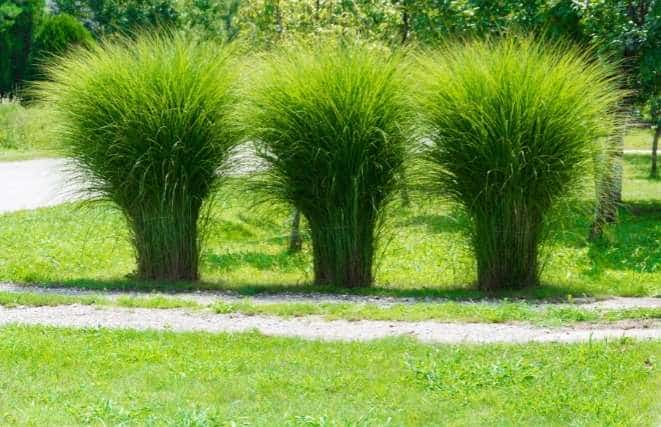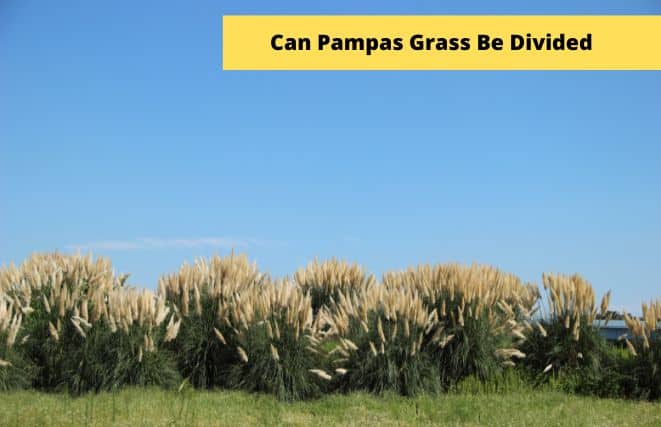Can Pampas grass be divided? Yes! Dividing Pampas grass is essential for its growth, vibrancy, longevity and beauty.
It is needed to maintain its natural beauty and proper shape. Just remember to use the right tools for an easier division and wear protective clothing for safety purposes.
Understanding Pampas Grass
Before we dive into the division process, let’s get to know Pampas Grass a bit better.
What is Pampas Grass?
Pampas Grass, known scientifically as Cortaderia selloana, is a striking and iconic plant known for its feathery plumes and tall, graceful appearance. Native to South America, it has found its way into gardens around the world, where it adds a touch of drama and elegance.
Pampas Grass in Landscaping
Pampas Grass is a popular choice for landscaping due to its many virtues:
- Dramatic Visual Impact: Its tall, feathery plumes create a striking focal point in gardens.
- Low Maintenance: Once established, it’s relatively low-maintenance, requiring minimal care.
- Privacy Screen: Its size and density make it an excellent natural screen or windbreak.
Can Pampas Grass Be Divided – Reasons to Divide Pampas Grass
- To separate male and female pampas grass to control invasion and excessive growth.
- To preserve the clump or desired shape and size of the grass.
- To create several new plants that you can add to your landscape.
When to Divide Pampas Grass
The best time to divide Pampas grass is in early spring or late fall (before growth starts). However, there are signs to know when you can specifically do the division.
- When a new Pampas grass plant emerging in spring, it is the best time to divide it. Dividing the parent grass gives space for the younger plant to grow.
Furthermore, grasses like Pampas do not grow until late spring, so it is best not to divide them until late spring or May. - When the center of the grass begins to clump, it is also the best time to divide it. The excess growth of old grasses causes clump that prevents the growth of new batch of grass.
- When the Pampas grass have spread too much and invade other nearby plants, it is also the best time to divide it.

How to Divide Pampas Grass
The process of dividing Pampas grass is a fairly easy task due to its height and large size.
Before dividing it, cut its foliage down to approximately 4-6 inches above the soil level and remove this large plant from the ground.
Here are the procedures on how to divide it properly.
- Lift grasses from the ground with a spade – use a digging spade to remove a section from the side of the root ball.
Take a healthy portion from the side of the root ball with at least five shoots and plenty of healthy roots. - Split the grasses using two forks inserted back to back in the center of the clump, then separate them apart.
Alternatively, cut the clump through the middle with a spade. - Repeat the division process until you reach the desired size of plant. As much as possible, remove smaller divisions from the clump by pulling them away from the parent plan
Important Reminders
- Plant the newly cut grass or plants into the ground as soon as possible.
- Use a heavy-duty, sturdy shovel with a sharp cutting edge, an axe or a pick (mattock) when digging out the clump of Pampas grass for an easier dividing and lifting extremely-large root balls out.
Special Considerations
Managing the Size of Pampas Grass
Pampas Grass can grow quite large, and managing its size is a common reason for division. Here’s how:
- Reduce the Clump Size: To control the size, you can divide your Pampas Grass and replant only a portion of it, leaving the rest to grow undisturbed.
- Regular Pruning: Routine pruning of the outer leaves and dead plumes can help manage the size and maintain the plant’s aesthetics.
Propagation of Pampas Grass
Another exciting aspect of Pampas Grass is the possibility of propagating new plants through division. Here are some tips:
- Select Healthy Divisions: Choose the healthiest and most vigorous divisions for propagation to ensure strong, thriving new plants.
- Plant Properly: Plant the divisions in well-prepared soil with good drainage and ample sunlight.
- Provide Adequate Care: Offer consistent watering and appropriate care to help the new plants establish themselves.
Common Mistakes to Avoid
To ensure a successful division of your Pampas Grass, steer clear of these common mistakes:
- Wrong Timing: Dividing Pampas Grass at the wrong time can stress the plant. Stick to the recommended division seasons.
- Excessive Division: Avoid dividing too aggressively, as it can weaken the plant.
- Over-Fertilizing: Refrain from applying too much fertilizer, especially immediately after division. It’s best to use a balanced, slow-release fertilizer sparingly.
- Planting Too Deep: Ensure that you don’t plant the divisions too deep. The root crown should be level with the soil surface.
Pampas Grass in Pots
Pampas grass can be an excellent choice for growing in pots and on balconies, provided you consider its specific needs and potential challenges associated with container gardening. Here are some key points to keep in mind:
- Container Size: Select a large and sturdy container to accommodate the mature size of pampas grass. The pot should have drainage holes to prevent waterlogged soil.
- Sunlight: Pampas grass thrives in full sun, so place your container where it will receive at least 6 to 8 hours of direct sunlight daily.
- Watering: While pampas grass is drought-tolerant once established, container-grown plants may require more frequent watering. Ensure the soil is evenly moist but not waterlogged.
- Fertilization: Fertilize sparingly with a balanced, slow-release fertilizer in the spring or early summer. Container plants benefit from nutrients provided by regular feeding.
- Pruning: Prune pampas grass in late winter or early spring to remove dead growth and promote new shoots. Be cautious while handling the sharp leaves.
- Overwintering: Potted pampas grass can be more susceptible to cold temperatures. In colder climates, consider moving the container indoors or into a protected area during the winter.
- Space: Due to its size, ensure your balcony or outdoor space can accommodate the height and spread of pampas grass without overcrowding or blocking views.
- Safety: Be aware that pampas grass leaves have sharp edges and can be irritating to the skin. Exercise caution when handling and pruning.
By following these guidelines and taking proper care of your potted pampas grass, you can enjoy its striking appearance and texture on your balcony or outdoor space.
When to Divide Ornamental Grasses?
Ornamental grasses are best divided either in the spring or the fall. Spring division is ideal for grasses that begin active growth at that time, promoting strong root development and lush spring and summer foliage. In contrast, fall division is suitable for grasses that become dormant during the winter, allowing them to establish new roots before the cold sets in. The choice between spring and fall division depends on the specific grass species and local climate conditions, so it’s crucial to consider these factors when determining the optimal time for division.
MORE: When to Divide Ornamental Grasses – Ornamental Grasses Care
FAQ About Dividing Pampas Grass
Yes, it is okay to cut pampas grass, and in fact, it’s a necessary part of its maintenance. Pruning pampas grass helps rejuvenate the plant, removes dead or damaged foliage, and promotes healthier growth. The best time to cut pampas grass is in late winter or early spring, just before the new growth begins. Be sure to wear protective clothing and use sharp pruning shears to make clean cuts. However, it’s essential to exercise caution due to the sharp and potentially irritating nature of pampas grass leaves, and consider proper disposal methods for the cuttings, as they can be invasive in some areas.
The best way to divide pampas grass is to use a spade, shovel, or garden fork. Dig down about 5 inches on either side of the clump, then cut through the soil with a spade or shovel and lift out the root ball. Divide each piece into smaller pieces by cutting it with a sharp knife or garden shears, then replant them in their new location.
There are various ways of reducing the size of this plant. One way is to cut the top leaves off and then use a weed killer on the plant. Another way is to cut off the entire plant at ground level, remove all roots and any fragments left behind, and then use a weed killer on the area where it was before planting new plants.
Conclusion
Pampas Grass can indeed be divided, making it a versatile and manageable addition to your garden. Perennials grass as Pampas grass must be divided every 3-5 years to clean and rejuvenate their old clumps, but in the case of Pampas grass, division or pruning is needed annually.
Whether you’re looking to control its size, rejuvenate an older clump, or propagate new plants, the process is achievable with careful consideration and proper technique. By understanding the needs of your Pampas Grass, following recommended timing, and providing post-transplant care, you’ll enjoy a thriving garden with the beauty of this iconic plant.








